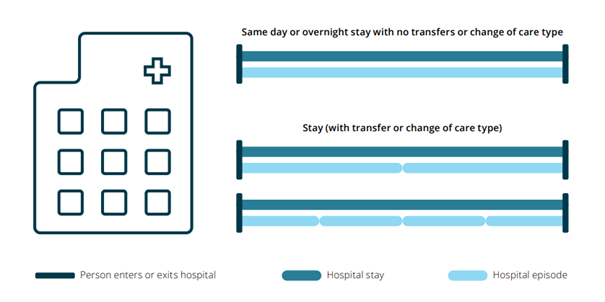Combining hospital episodes into hospitalisations
Creating hospital stays, and examining transitions between overnight hospitalisations and residential aged care
Hospital data are episodic in nature, meaning that, while from a person’s perspective they may have had one hospital stay with some moves between hospitals or wards, from a data collection perspective the patient had several adjoining individual episodes of care with an admission date and discharge date for each. A hospital episode can be:
- a total hospital stay—from admission into hospital to discharge from hospital or death
- a portion of a hospital stay beginning and/or ending in a change of care type (for example, from acute care to rehabilitation). Episodes ending with a change in care type in the same hospital are reported as ending in a statistical discharge.
- a portion of a hospital stay beginning and/or ending in a transfer from/to another hospital (Figure 18).
Figure 18 Conceptual diagram of relationships between hospital episodes and hospital stays

Hospital episodes are useful for measuring activity in the system—and some of the information recorded on admission mode, care type or episode end status can give an indication as to whether the episode of care was, for example, transfer from another ward or hospital—but does not readily capture a full hospital stay.
Therefore, to capture a person’s experience in hospital more accurately, this analysis used a set of rules to combine a person’s individual hospital episodes into hospital stays. At the broad level, hospitalisations are defined here as the period from admission into the hospital system to discharge from it (or death in hospital). Individual hospital episodes were brought together to identify the start and end dates for periods in hospital; that is, distinct hospital stays. To quantify movement between hospital and residential aged care (RAC), these dates were then be compared against RAC dates to identify whether people lived in RAC before and/or after their hospital stay.
Emergency department (ED) data were used to combine hospital episodes for people who transferred between hospitals via the ED during their stay. ED presentations prior to admission were also reported, but any time spent in the ED prior to admission did not count toward the person’s total length of hospital stay.
Defining transitions
A person can have a hospital stay that lasts for one or more days. This analysis defines a transition as a situation where a person physically moves from one place to another (e.g., from RAC to a hospital) and stays there for at least one night. Therefore, same-day hospital stays were excluded from the analysis. This definition of a transition is consistent from previous work in this area (Aaltonen et al.2011; Sivananthan et al. 2016).
References
Aaltonen et al. 2011. The impact of dementia on care transitions during the last two years of life. Age and Ageing 41:52-57.
Sivananthan et al. 2016. Diagnosis and disruption: population-level analysis identifying points of care at which transitions are highest for people with dementia and factors that contribute to them. Journal of the American Geriatrics Society 64(3):569-577


